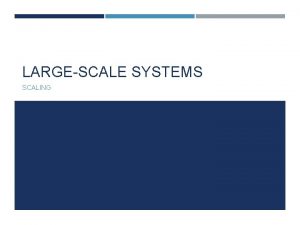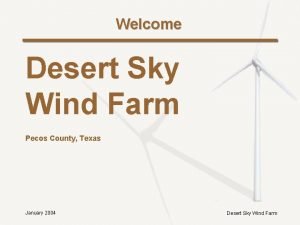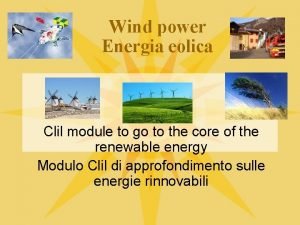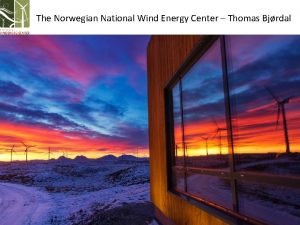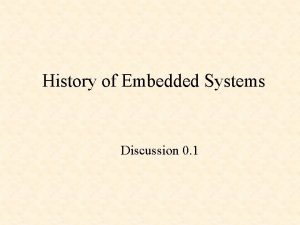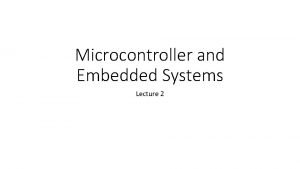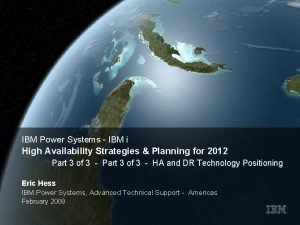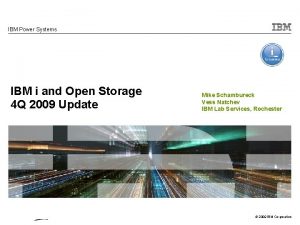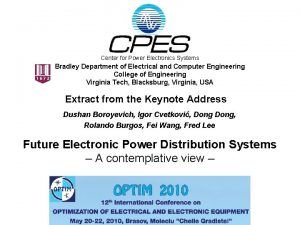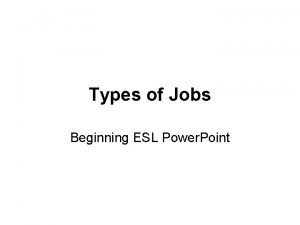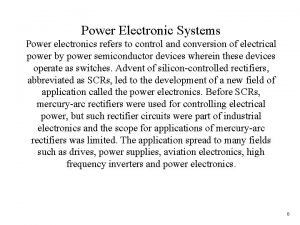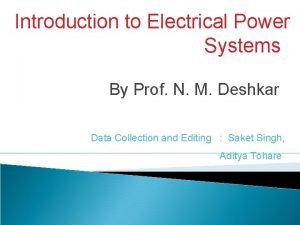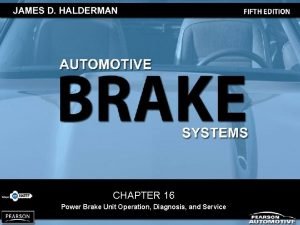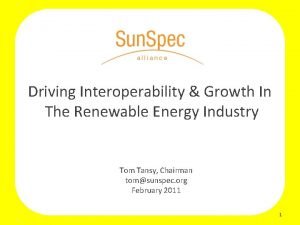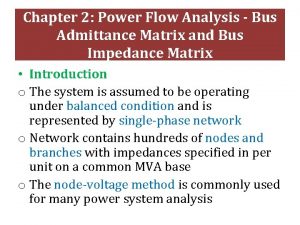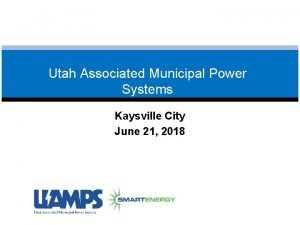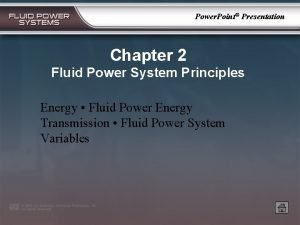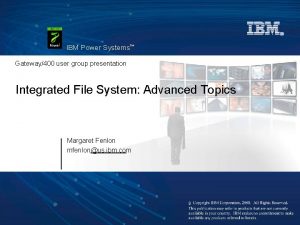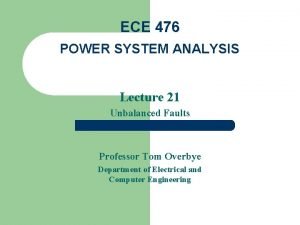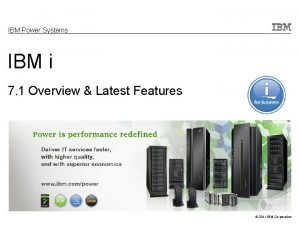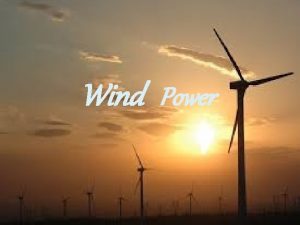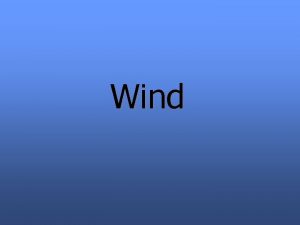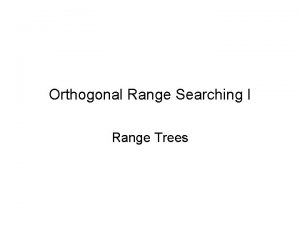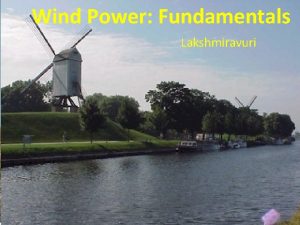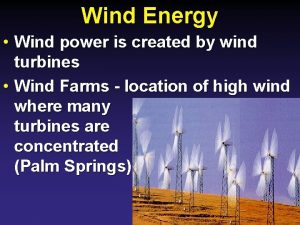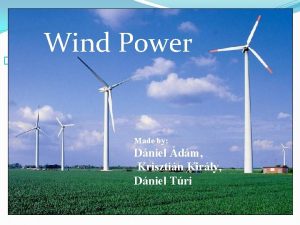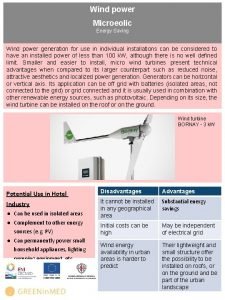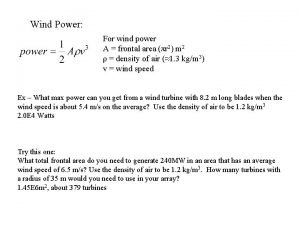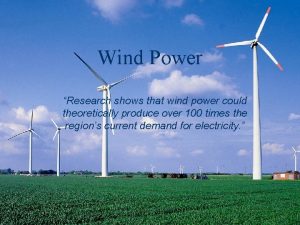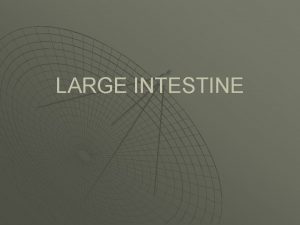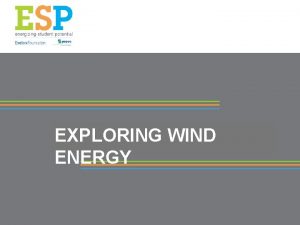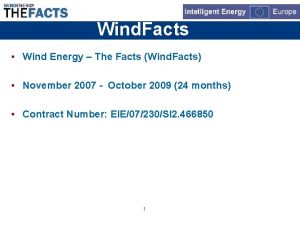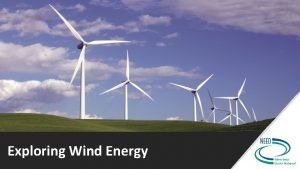History of Wind Power Large Wind Systems Range








































- Slides: 40

History of Wind Power

Large Wind Systems Ø Range in size from 100 k. W to 2 MW Ø Provide wholesale bulk power Ø Require 13 mph average wind sites

Technology Overview - Large Wind Projects Ø Projects operating at greater than 35% capacity factors at good wind sites Ø Over 98 -99% availability Ø Select projects are delivering power ~ 3 cents/k. Wh (with Production Tax Credit)

Levelized Cost of Energy (cents/k. Wh) Cost of Energy - Large Wind Projects 12 10 8 6 4 2 1990 1995 2000 2005 2010

Fastest Growing Energy Source in the World Source: Worldwatch Institute 2000 Global growth by energy source, annual average 1990 -1999

Taking Off Worldwide Wind Leaders: 1. Germany 2. United States 3. Spain 4. Denmark 5. India Total (end of 2000): nearly 17, 000 MW Based on information supplied by International Energy Agency.

2000: A Year for Market Innovations Ø Several companies begin selling green power certificates Ø Several states see first largescale wind power project: PA, NY, TN Ø Texas RPS fuels building boom

2001: Wind Power Expected to Take Off Ø US Wind Capacity expected to nearly double by the end of 2001 Ø The Northwest will see the largest US wind project to date with the Stateline Wind Farm (300 MW)

An All American Resource Rank World Class Wind Potential Germany’s Potential: 100 GW North Dakota’s Potential: 250 GW 1 2 3 4 5 6 7 8 9 10 11 12 13 14 15 16 17 State North Dakota Texas Kansas South Dakota Montana Nebraska Wyoming Oklahoma Minnesota Iowa Colorado New Mexico Idaho Michigan New York Illinois California


Drag Device

Giant Brush Windmill (1887 – 1900 s) Ø Charles Brush Ø Automatically operated Ø Dynamo Ø Charged batteries Ø Provided light

Earliest Use Ø May be sail boats Ø Persia 500 - 900 A. D. - Drag, Vertical Axis Device - Panemone - Grain Grinding & Water Pumping Ø China 1219 A. D. - Grain Grinding & Water Pumping Ø Crete - Water pumping for livestock.

Windmills of Western World (1270 Mediterrean Coast) Ø Horizontal Axis with Sail Wings Ø Higher Efficiency Ø Wooden Cogs and Ring Gears to Transmit Power.

Halladay Fan-Type Windmill (1854 in U. S. ) Ø Water Pumping Windmill Ø Pumping water for livestock. Ø Relatively light, steel blades with aerodynamic shape. Ø Blades hinged to fold in high winds. Ø Tail to track wind direction.

Windmill with Pitch Change Mechanism

Palmer Putnam’s Windmill

Darrieus Machine (1973) Ø NASA sponsored research during oil crisis. Ø No tower and major equipment at ground level. Ø Marketed by Flo Wind Ø Failed to withstand forces during high winds Ø Never caught on.

Early, Large 2 MW Machine (Early 1980 s. ) Ø Developed by NASA. Ø Response to problem with downwind machine of Ulrich Hutter. Ø Large loads. Ø Noisy. Interfered with communications. Ø Tested in Boone, NC and Hawaii.

Another Early MW Machine

Federal Wind Test Center (1974 -1981) Ø Tested Small & Intermediate Wind Turbines Ø Culled bad designs. Ø Bergie Design is spinoff. Ø UTRC's Composite, Flexbeam Rotor Ø NREL assumed control in 1989.

Danish Machines (1942) Ø F. L. Smidth early designs Ø Three Blade Upwind Machine Ø Hybrid wind & diesel systems. Ø DC Generator

Vester Egesborg Turbine (1950 s) Ø Johannes Juul Ø Student of Poul La Cour Ø First ac machine.

Gedser Wind Turbine (1956 -1957) Ø Johannes Juul Ø Electromechanical Yawing Ø Asynchronous Generator Ø Stall Controlled Ø Special brakes for overspeed conditions.

The Riisage Turbine

Competing Turbine Engines

The Tvind 2 MW Machine

Bonus 20 KW

Danish Domination of 1990 s Ø Slow, steady growth in Europe & Asia Ø Mid-range machines Ø Reliable with high availabilities. Ø Conservative, Lower Efficiency Ø American Company - Zond emerged Ø Green Power, State RPS program, & Tax credits kickstarted American Market in late 1990 s.

Great California Wind Rush (1980 s) Ø Tax Credit based on installed capacity. Ø Lots of bad wind turbines installed. Ø Lot of turbines were inoperable and had high O&M. Ø Conservative, Danish machine emerged.

Avedore Wind Farm, Denmark

Middelgrunden Wind Farm

Tuno Knob Offshore Wind Farm

Vindeby Wind Farm

TVA History Ø In 1980 s • Tested a 2 MW machine. • • – numerous problems Tested small machines at various locations. Conducted extensive siting Ø 2000 • • • Re-examined earlier work Meso scale computer modeling Sodar development Monitoring Walk-throughs Ø October 2000 • Commissioned 2 MW project on Buffalo Mountain

Future of Wind Power Ø Expect cost to continually drop ($0. 02/kwh by 2010) • • Taller towers Increased efficiency, less expensive blades – wood composite • Drive trains – Direct drive – Power electronics • Revolutionary change – The Wind Power Company down 2 blade machine • Larger size (1. 5 – downwind 3. 0 MWs)

Future of Wind Power - continued Ø AWEAs estimates 100, 000 MW in USA by 2020. Ø Transport of wind power from plains states. Ø Off shore wind development


Future for the Tennessee Valley Ø Ø Ø Taller towers Self erecting towers Different Power Test procedures Sodars for wind resource measurements Low wind speed turbines Energy storage

TVA’s Plans Ø Ø Ø RFP for wind power on Buffalo Mountain. Online by December 2003. Prefer Power Purchase Agreement. Expansion for Green Power Switch. May partner with neighboring utilities.
 Draw the power triangle
Draw the power triangle As compared to long-range forecasts, short-range forecasts
As compared to long-range forecasts, short-range forecasts Raumschotkurs
Raumschotkurs Large scale systems
Large scale systems Pecos wind power
Pecos wind power Advanteges of solar energy
Advanteges of solar energy Wind energy is an indirect form of
Wind energy is an indirect form of Pros and cons of electrical energy
Pros and cons of electrical energy Wind power energia
Wind power energia Wind power norway
Wind power norway Decision support systems and intelligent systems
Decision support systems and intelligent systems Principles of complex systems for systems engineering
Principles of complex systems for systems engineering Embedded systems vs cyber physical systems
Embedded systems vs cyber physical systems Engineering elegant systems: theory of systems engineering
Engineering elegant systems: theory of systems engineering One billion
One billion History of embedded systems
History of embedded systems History of payment systems
History of payment systems Ibm power systems technical university
Ibm power systems technical university Cyber power systems inc
Cyber power systems inc Ibm geographically dispersed resiliency for power systems
Ibm geographically dispersed resiliency for power systems Ibm aix high availability
Ibm aix high availability Storage for ibm power systems
Storage for ibm power systems Hamilton sundstrand power systems
Hamilton sundstrand power systems Center for power electronics systems
Center for power electronics systems Esl power systems jobs
Esl power systems jobs Power electronic systems
Power electronic systems J-power systems corporation
J-power systems corporation Introduction to electrical power systems
Introduction to electrical power systems Batten wiring
Batten wiring Unit 5 quiz 1 power assist systems
Unit 5 quiz 1 power assist systems Energy power systems
Energy power systems Ybus matrix
Ybus matrix Utah associated municipal power systems
Utah associated municipal power systems Fluid power system ppt
Fluid power system ppt Power systems
Power systems Power systems
Power systems Hrsg boiler diagram
Hrsg boiler diagram Nmon 설치
Nmon 설치 Ldhtest
Ldhtest Orc power systems
Orc power systems Also history physical
Also history physical



